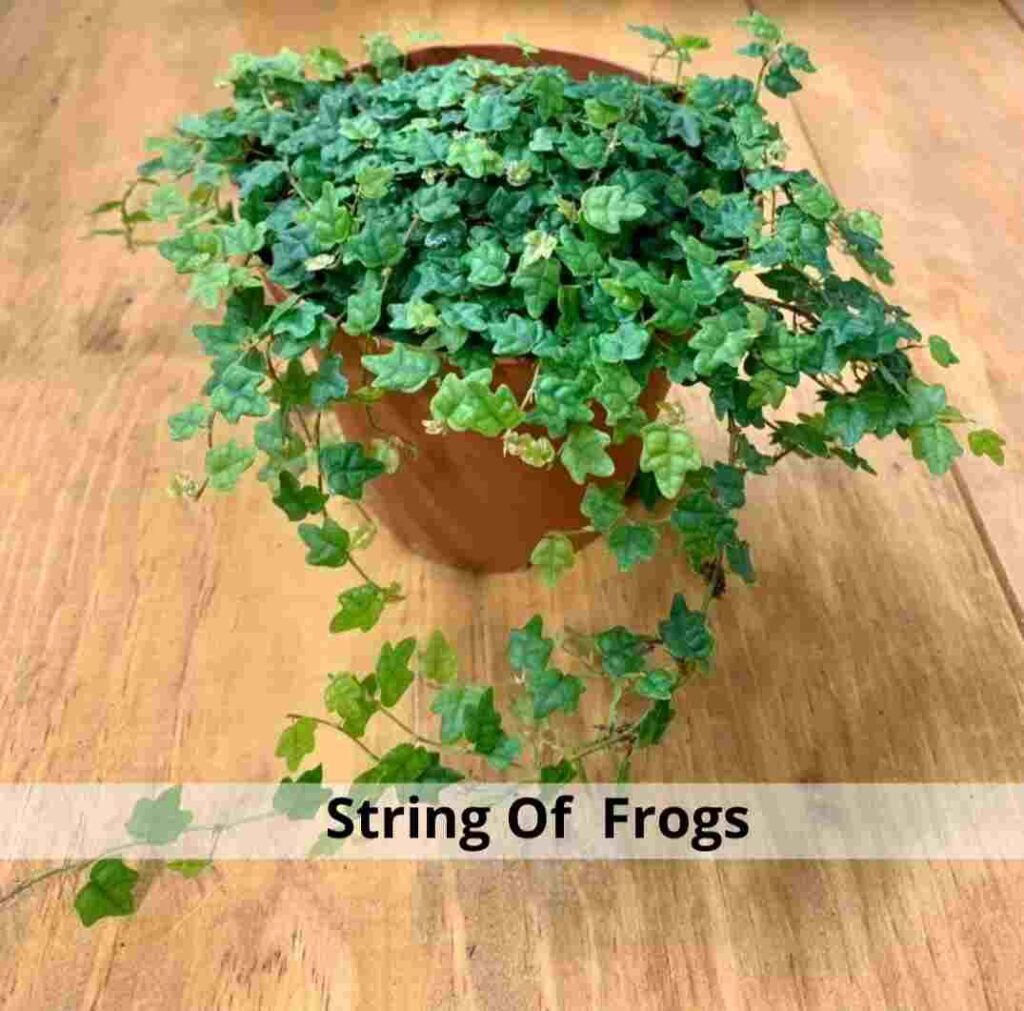The string of frogs is an intriguing and unique houseplant that is exploding in popularity right now. Its dangling stems bear glossy, oak-shaped leaves that closely resemble cute little frogs sitting in a row.
While they look delicate, string of frog plants are not too difficult for beginner houseplant owners to care for By understanding their basic needs and following a few simple care tips, you can keep your string of frogs healthy and happy
An Overview of String of Frogs
String of frogs is one of the many common names used for the Ficus pumila cultivar ‘Quercifolia’. As its name suggests, this variety has tiny leaves that are distinctly shaped like oak leaves. Other nicknames include oak leaf creeping fig and creeping fig.
Native to East Asia, string of frogs is an evergreen vining plant. Given proper support, the stems can grow several feet long and cascade attractively. Outdoors, it climbs up trees and spreads as a groundcover. The leaves are typically about 0.5 inches long.
One of the keys to success with string of frogs is providing the right care and environment to match its tropical origins Below I’ll walk through everything you need to know to keep your plant healthy indoors
Light Requirements
String of frogs needs abundant bright, filtered light to thrive Direct southern exposure from a sunny window is ideal. Avoid direct sunlight, which can scorch the leaves, but do not allow the plant to sit in low light conditions either.
If you don’t have a bright window, consider using a grow light to supplement natural light. Pay close attention to the foliage, as insufficient light will cause the leaves to become more elongated in shape.
Ideal Temperature and Humidity
As a tropical plant, string of frogs prefers warm temperatures between 60°F to 80°F (15°C to 26°C). It can tolerate short drops to 50°F (10°C) at night. Avoid drafty areas.
Average indoor humidity is fine for a string of frogs. Mist the plant occasionally or use a pebble tray to boost moisture levels. Just take care not to allow the foliage to remain wet, which encourages fungal disease.
Potting Mix and Drainage
A well-draining potting mix is critical to avoid overwatering string of frogs. Use a commercial cactus/succulent soil or make your own blend with ingredients like perlite, sand, orchid bark and peat moss. The soil should dry out partially between waterings.
Always choose containers with bottom drainage holes. Plastic pots work well and help retain moisture. For hydroponic growing, LECA clay pebbles are a good option.
Watering Frequency
String of frogs prefer slightly drier conditions than many houseplants. Water thoroughly when the top inch or two of soil is dry, then allow the pot to drain fully. This may mean watering as infrequently as every 2-3 weeks in the winter when growth slows.
Droopy, wrinkled leaves indicate under-watering. Overwatering can lead to root rot and dropping leaves. Adjust your schedule based on factors like light, temperature and humidity.
Fertilizer Needs
During the spring through fall active growing season, feed string of frogs monthly with a balanced houseplant fertilizer diluted to half strength. Any all-purpose plant food will work. Stop fertilizing over the winter when light levels and temperatures drop.
If you use rich, organic potting mixes, you can likely fertilize even less without deficiency. Leach excess salts by watering thoroughly every few months.
Pruning and Training
Prune string of frogs any time to remove dead or damaged growth. To control size and shape, cut stems back by up to one third after the growing season ends in late fall.
Place a moss pole, trellis or other support in the pot and gently tie stems in place. This encourages climbing growth. Avoid overcrowding the stems, which can lead to fungal issues.
Repotting and Propagation
Repot string of frogs every 2-3 years in the spring, moving it to a container that is 2 inches larger. Trim any circled roots and use fresh potting mix. You can propagate new plants from stem cuttings.
Common Problems
- Leaf drop – Caused by overwatering, low humidity or cold drafts
- Leaf spots – Fungal disease from excess moisture on leaves
- Leggy growth – Not enough sunlight
- Root rot – Wet soil and poor drainage
Tips for Success
- Provide bright, filtered sunlight without direct rays
- Use porous potting mix and pot with drainage holes
- Allow soil to dry out between waterings
- Increase humidity with pebble trays or misting
- Feed monthly during spring and summer with fertilizer
- Prune and train stems to control shape
With its cute, frog-shaped foliage, string of frogs offers a uniquely whimsical look that starters as well as experienced plant parents can enjoy growing. Just be sure to choose a warm, bright location and avoid overwatering. Let the soil dry out moderately between waterings. With a little practice, you’ll master the art of caring for this darling vining plant!
String of Frogs, Ficus quercifolia, aka “Mini Ivy” have Tiniest of Tiny Leaves, Dec2021
FAQ
How often should you water a string of frogs?
How to keep strings of frogs alive?
- The Ultimate Guide to Growing Strawberries in Raised Beds - August 8, 2025
- No-Dig Garden Beds: The Easiest Way to Grow a Beautiful Garden - August 6, 2025
- How to Protect and Preserve Wood for Raised Garden Beds - August 6, 2025

